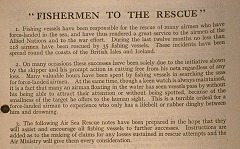Back to start | The World Wars (i) | Next
The World Wars (ii)

The fishing boats were active service vessels. This meant that they were a target for enemy submarines, gunships and aircraft. Those on patrol or on minesweeping duties were fitted with weapons so that they could defend themselves. However, other boats continued fishing. Fish was a very important source of fresh food during the war and was never rationed. These boats too were vulnerable. Fishing was a reserved occupation during both World Wars. This meant that some fishermen were allowed to continue fishing and were not called up for military service. The fishing industry was therefore able to continue, although crews were depleted.
The dangers of war continue for fishermen long after the wars ended. Unexploded mines planted by submarines are still found today. If these are hauled up in nets, they can easily sink a boat. The remnants of wartime defences also litter the seabed. These include tank traps, which are large concrete blocks positioned around many of the beaches of east Scotland. Many of these are invisible above the water at high tide. In January 2003, a Pittenweem boat the Amber was tragically sunk with the loss of the single crewman. It is thought that the anchor of an anti-submarine net, a submerged galvanised steel net, caused the sinking. These nets were strung across a channel to trap German U-Boats. The anchor became trapped in the nets and, as the fisherman attempted to drag it closer to shore so that it could be removed, it fell down a deep trench, pulling the boat down after it.
The fishing industry was invaluable in the World Wars. As well as supplying food, they rescued shot-down airmen, provided many expert seamen and useful boats. In doing so, however, they suffered casualties and hardship.
Back to start | The World Wars (i) | Next